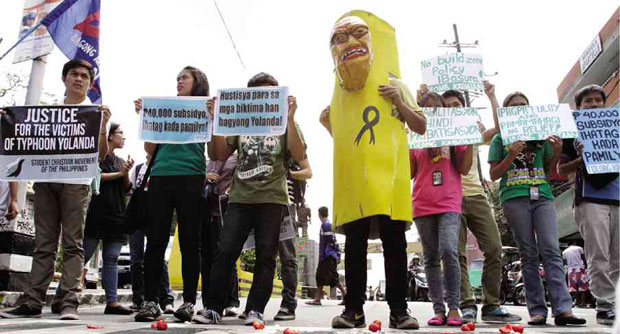Tribal group decries focus on lowland aid

ROTTEN tomatoes and eggs are strewn on the pavement after these were used by activists to pelt an effigy of President Aquino during a protest action on Mendiola on Friday denouncing what they said were Mr. Aquino’s insensitive remarks against survivors who had been demanding cash aid, which the President flatly rejected. GRIG C. MONTEGRANDE
ILOILO CITY—Panay’s largest indigenous peoples group has appealed to the government to also help victims of Supertyphoon “Yolanda” in hinterland communities and not only those near coastal areas and town centers.
“We have yet to recover nearly four months after Yolanda because most of the help is concentrated in the lowlands and coastal areas,” said Marivic Aguirre, chair of Tumanduk nga Mangunguma nga Nagapangapin sang Duta kag Kabuhi (Tumanduk).
Tumanduk is an alliance of 17 indigenous peoples communities in Tapaz and Jamindan towns in Capiz province and Calinog town in Iloilo province.
Aguirre, also village chief of Lahug in Tapaz, said the indigenous peoples received far less food and other aid because they were deemed too inaccessible.
“We still need food. Even monkeys are coming out of the forests looking for something to eat,” Aguirre told the Inquirer.
Article continues after this advertisementLahug, which has 60 residents, is at least 18 kilometers from the town proper of Tapaz.
Article continues after this advertisementShe said since Yolanda struck on Nov. 8 last year, each family in her village received 6 kilograms of rice, biscuits and canned food from the Department of Social Welfare and Development distributed at the town center. They also received tarpaulin sheets.
“These were not enough because almost all houses in our barangay were destroyed,” she said.
Aguirre said the tribe also received help from nongovernment organization Panay Center for Disaster Response.
Out of 60 houses in the village, only 15 are left standing but these were also damaged. The barangay hall, chapel and a two-classroom school were destroyed.
She said the hinterland villages lost their source of livelihood because Yolanda flattened rice lands and coffee farms and uprooted banana trees.
“It will take a year for us to harvest from banana trees and five years for coffee. It’s difficult to find food because the trees and plants are gone,” Aguirre said.
The Tumandok people, estimated to reach 18,000, are also called Sulodnon and Bukidnon by scholars.
They are known for their rich oral literature that has gained international recognition.